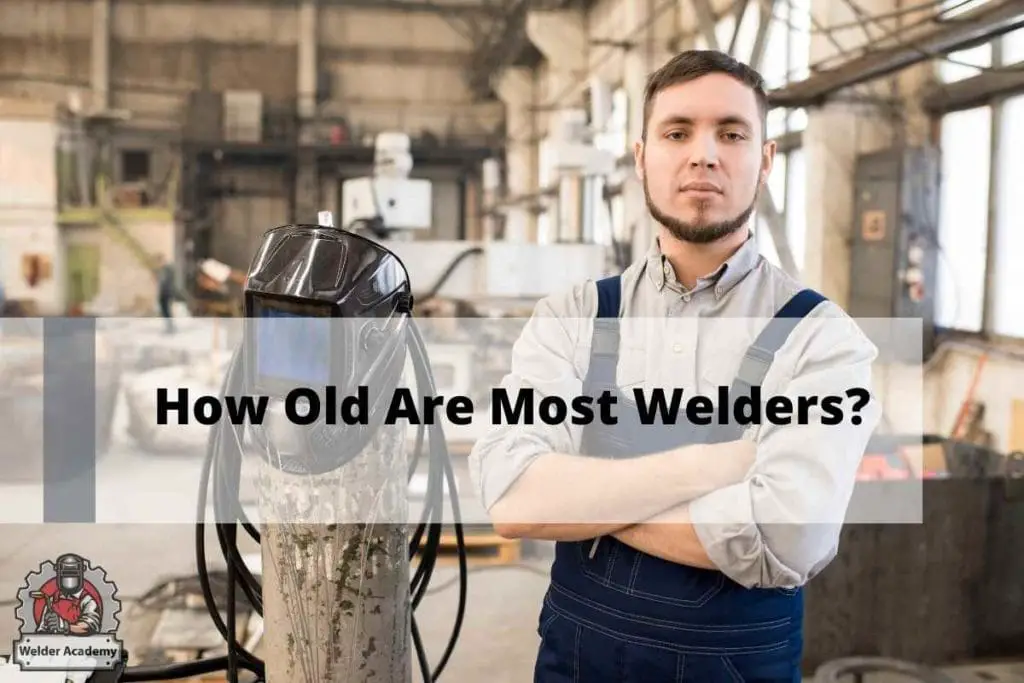Being young and interested in welding must leave you with numerous unanswered questions. Like, how old are welders, and does welding shorten or affect the lives of welders? Well, many things go into consideration here.
The age range of welders varies from over 16 years old to over 65 years old. The average age of welders falls between 25 and 54 years. While some start welding at an early age, such as in their late teens, others join in their mid-twenties. Many even stick to welding into their early seventies.

Nonetheless, there are quite a few concerns in the welding industry, especially exposure to toxic particles and whether it affects the life of a welder. So, let’s take a closer look at what’s in store for you in this industry and what precautions you should take.
What Is The Average Age Of Welders?
The average age of welders is between their late twenties and early thirties. The majority of them start their career after completing an apprenticeship or a certificate program to qualify. Once one starts their career down this path, they rarely choose to switch professions mid-way and stick to this job till retirement.
On average, many welders start their careers in their late teens or early twenties due to their passion for this field or for financial reasons, as welding is a well-paid job and it’s easy to start a career in this field. Around 1 in 5 welders in the USA are in their 40s or 50s. Check out the table below, by BLS, for a detailed breakdown of the year 2021.
| Average Welder Age | Number of Welders (in thousands) |
| Total, 16 years and above | 555 |
| 16 – 19 years old | 19 |
| 20 – 24 years old | 76 |
| 25 – 34 years old | 128 |
| 35 – 44 years old | 119 |
| 45 – 54 years old | 110 |
| 55 – 64 years old | 89 |
| 65 years and over | 14 |
Accordingly, the median age of welders is 40 (median refers to the age such that half of the welders are younger and half are older than this age). Now, although there’s a demand in the welding industry and it’s a good choice as a green-collar job, there are many health hazards linked with it. But, do these hazards affect the life expectancy of a welder?
The Work Environment Of Welder
Welders tend to work both outdoors and indoors. If they work outdoors, they often have to deal with unpleasant and harsh weather conditions. They also sometimes work on platforms lifted off the ground. They even have to lift heavy objects and work in awkward positions from time to time.
Whereas, indoor work is usually performed in a confined area designed to contain sparks, blazes, and fumes. Indoor work also requires the similar effort of lifting heavy objects and working in awkward positions. Almost all welders work full time, and working overtime in this industry is quite common.
Typically, welders do the following types of work:
- Study details and instructions before welding
- Inspect the material and calculate the dimensions of the parts that they’ll weld
- Turn on all the power supplies and high heat sources
- Monitor and maintain the welding environment to control the fumes and sparks
- Cut, melt, and join metal parts into proper shapes
As welding is used in a variety of fields like aerospace, automobile, shipbuilding, etc., the work and machinery vary for each field. Regardless, all welding requires high heat to melt and bond metal pieces. Arc welding, another popular form of welding, uses electric current to produce heat and join metals together. All of these methods carry their own dangers.
Work Hazards And Their Effects
Unfortunately, there’s a risk of injury in this line of work. This is because welding requires very high heat—roughly 2800 °F or more—to melt and bond the metal pieces. Hence, the sparks from the welding process and the long hours that go behind it get dangerous, tiresome, and exhausting.
Consequently, welders face numerous hazards due to hot materials, toxic fumes, and intense light (in the case of ac welding) while welding. Welding fumes also release a pungent smell (called a “fume plume”).
There are many risks in dealing with fumes and blazes from welding, such as fires and explosions. There might also be fatal accidents due to the welding of pressurized containers such as fuel tanks.
Cleaning such containers before welding ensures a safe session. Skin burns are also common while welding. Although temporary, they cause quite a bit of discomfort.
Welders tend to suffer from back, neck, and joint pains due to working in awkward positions. However, re-positioning the workstation to weld comfortably can reduce such pains. Other non-fatal effects of welding include bronchitis, metal fume fever, coughing, shortness of breath, irritations around the body, among several others.
There are many deadly effects due to prolonged exposure to metal fumes. Some include heart diseases, stomach problems, kidney damage, cancer, Parkinson’s syndrome, and neurological problems. Most welders also tend to suffer from respiratory illness in the long term.
Certain metal fumes, such as cadmium, also cause fatal accidents. The problem lies in the fact that most welders don’t know if they are dealing with such metals while welding. Inhaling these metal fumes causes serious health damage.
Effect On Life Expectancy
There are records of welders experiencing fatal accidents in workplaces during the early 2010s. Some health hazards result due to prolonged exposure to welding. Although newer safety equipment helps avoid many fatal accidents, certain health hazards due to prolonged exposure to welding remain.
Due to the latest implementation of policies and regulations, welding is becoming a safe practice. Such as the regulations by OSHA, which state that safe ventilation is a top priority in a welder’s workplace to avoid the danger of inhaling welding fumes and toxic particles that remain as debris from welding.
Although there are many steps yet to be taken, a welder can substantially minimize injuries if they follow all the safety precautions. In doing so, the welding process won’t affect a worker’s life expectancy.
Check out full article on: Does Welding Shorten Your Life Expectancy?
Tips On Welding Safety
Every welding workplace strictly follows many precautions now to significantly decrease the health hazards and risks related to welding. So, if you make sure to do the same, you’ll be good to go! Some important tips to reduce injuries are:
- For protection against flammable fumes and gases, wear appropriate personal protective equipment (PPE) like heavy-duty aprons, gauntlet heat-resistant gloves, and coveralls that don’t burn easily to prevent burns.
- When cutting metals, wear a face shield that covers the full front of the head to protect the face from injuries produced by flying sparks, as well as safety equipment such as masks and goggles to prevent eye injuries.
- Wear steel-toed boots and coveralls to protect against heavy and sharp falling objects and sparks.
- Use a fume extraction hood to keep fumes away from your face and prevent inhalation of harmful pollutants. Or, cover your face with a respirator mask. These masks filter out harmful particles while still providing fresh air.
- Ensure proper ventilation in your workplace. This will filter welding fumes and give proper air circulation.
Conclusion
As welding is a painstakingly slow process and has many health hazards, younger generations tend to stay away from this profession. However, if you’re interested in this profession, then questions like how Old Are Welders shouldn’t stop you from pursuing it!
Just make sure to take all safety precautions and you’re good to go! Thank you for stopping by!
